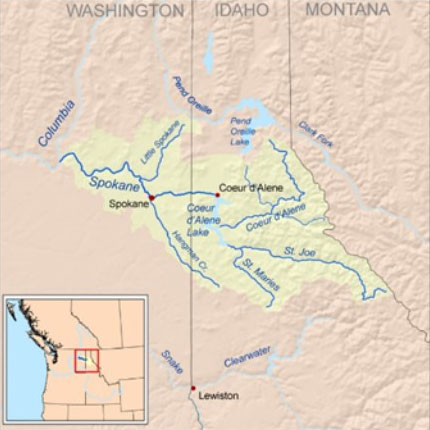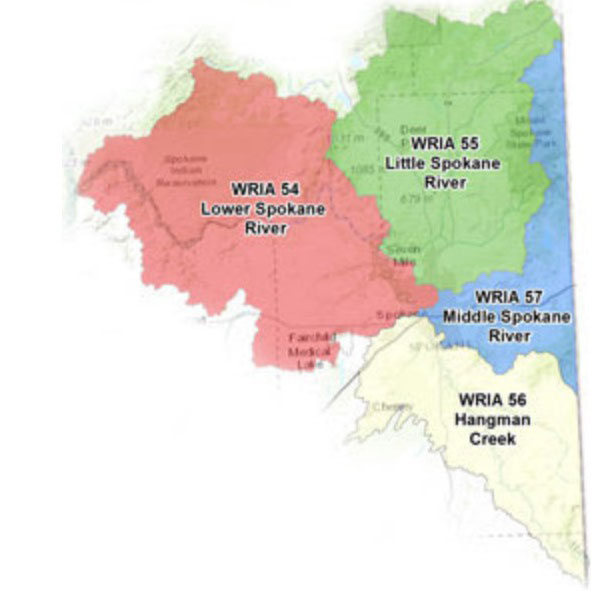Geographic Area | Species | Organization & Funding
In February 2024, the Washington State Recreation and Conservation Office (RCO) recognized the Spokane Salmon Restoration Collaborative (SSRC) as the Spokane River watershed lead entity. Within the RCO, the Governor’s Salmon Recovery Office (GSRO) contracts with seven regional organizations and twenty-six watershed-based organizations called lead entities to help implement the salmon recovery strategy.
Washington State’s Salmon Recovery Act, specifically RCW 77.85.050, authorizes the formation of “lead entities.” As stated in the Salmon Recovery Funding Board Manual 19, “Lead entities develop local watershed strategies, make funding recommendations to the state’s Salmon Recovery Funding Board (SRFB), and coordinate funding and implementation of habitat projects in their areas.”
Background and Mission
Historically, lead entities develop habitat restoration and recovery plans for Endangered Species Act (ESA) listed salmon and trout. Salmon, however, are currently blocked from the Northeastern Washington region by Chief Joseph and Grand Coulee Dams (and before that the Spokane River by dams built by Washington Water Power, now Avista). For this reason, there is only one lead entity in Northeastern Washington (the Pend Oreille Salmonid Recovery Team), which is focused on recovery of ESA listed bull trout.
In 2021, the GSRO invited the Spokane Tribe of Indians (STOI) to develop a lead entity for the Spokane River Watershed. This invitation supports Upper Columbia United Tribes (UCUTs) efforts to reintroduce non-ESA listed salmon in the Upper Columbia Basin above Chief Joseph Dam. Historically, millions of adult salmon returned to this area.
In the 2010s, the Upper Columbia United Tribes (UCUTs) and their partners began evaluating the possibility of salmon reintroduction to the Upper Columbia Basin above Chief Joseph Dam.
In 2019, the UCUTs completed the Fish Passage and Reintroduction Phase 1 Report. The report
- evaluated fish passage studies at hydroelectric projects, including Chief Joseph and Grand Coulee dams,
- investigated habitat availability, suitability, and salmon survival potential in habitats above Grand Coulee Dam, and
- investigated possible costs of upstream and downstream passage options.
The report, which was favorably reviewed by the Northwest Power and Conservation Council’s Independent Scientific Advisory Board, concluded that reintroduction is viable for the non-ESA listed Chinook and Sockeye species evaluated. Specific to the Spokane River Watershed, 2018 Ecosystem Diagnostic Treatment (EDT) modeling also validated the opportunity for salmon reintroduction.
In 2022, the UCUTs released The Phase 2 Implementation Plan (P2IP): Testing Feasibility of Reintroduced Salmon in the Upper Columbia River Basin. Inclusive of the Spokane watershed, P2IP is “a stepwise and scientifically adaptive approach to test the feasibility of restoring salmon to the Upper Columbia River basin that is focused on collaboration, cost effectiveness, and benefits for the entire region.”
Within this context, the SSRC mission is to develop and implement a habitat restoration strategy that supports salmon reintroduction and preservation of Native Redband Trout.
Watershed Geographic Area
The Spokane River Watershed is about 6,240 square miles. Approximately one-third of the watershed is in Washington, and the remainder in Idaho. Its headwaters are located high in the temperate forests of north Idaho with drainage connecting to the Columbia River at Lake Roosevelt.
Natural resources include forests, mineral rich deposits, mining, and fertile agricultural areas. It also includes the Spokane Valley – Rathdrum Prairie (SVRP) aquifer, which is the sole source of drinking water to over a half million people.

The Washington State portion of the Spokane River Watershed lies within Water Resource Inventory Areas (WRIA) 54, 55, 56, and 57. The Spokane River, which is 111 miles long, and its tributaries are major features. The WRIAs are predominantly in Spokane, Stevens and Lincoln counties. A small area of the Little Spokane drainage is within the southern area of Pend Oreille County, and the tip of the Hangman Creek drainage is in northeastern Whitman County.

The region is also inclusive of the Spokane Tribe of Indians Reservation, and the usual and accustomed areas of both the Spokane and Coeur d’Alene tribes. The Coeur d’Alene Reservation in Idaho includes the critical upper area of the Spokane River Watershed Hangman Creek drainage.
Focal Species
SSRC habitat projects will focus on preparing our waters for the reintroduction of non-ESA listed spring and summer/fall Chinook in the Spokane River Watershed. Projects will also prioritize improving habitat conditions for native Redband Trout, which are ancestrally linked to extant Steelhead populations. The United States Fish and Wildlife Service lists Redband Trout in this watershed as a species of concern and a collaborative inter-agency conservation effort formed in 2016.
Formation, Organization and Funding
A lead entity is formed when counties, cities, and tribal governments within a geographic area jointly designate, by resolution or by letters of support, the area to be served. For SSRC, initiating governments include Spokane County, Stevens County, Lincoln County, City of Spokane, Spokane Tribe of Indians and the Coeur d’Alene Tribe of Indians.
Per statute and state guidance, the SSRC consists of:
- A coordinator, the Spokane Tribe of Indians, to serve as the fiscal agent and provide necessary staffing.
- A technical committee, consisting of local experts knowledgeable about our watershed’s habitat and fish conditions.
- A citizens committee, consisting of elected officials, agencies, stakeholders and others grounded in our community’s social, cultural, and economic values.
In the spring of 2022, the Technical Committee comprised of local and technical experts knowledgeable about local watershed, habitat and fish conditions was formed. Its immediate purpose is to support the development of a Spokane River Watershed Habitat Restoration Strategy and Plan. The Plan is foundational to the technical committee’s long-term purpose to identify, review and prioritize habitat projects based on the best available science.
The technical committee currently includes representatives from Avista, City of Spokane, Coeur d’Alene Tribe, Eastern Washington University, Inland Northwest Lands Conservancy, Lands Council, Pend Oreille Conservation District, Spokane Conservation District, Spokane County, Spokane RiverKeeper, Spokane Tribe of Indians, Trout Unlimited, Washington Department of Ecology, and Washington Department of Fish and Wildlife. On an ad hoc basis, there is also participation from other area colleges and universities, non-government organizations, tribes and interested stakeholders.
During the summer of 2024, initiating governments will meet to form the citizens committee. When the technical committee ranks habitat projects for Salmon Recovery Funding Board (SRFB) funding consideration, the citizens committee will review and determine whether to re-rank projects before submission to the SRFB.
SSRC is funded by the Washington State Legislature through the SRFB. Contracts to distribute funding are administered by RCO. Funding or in-kind contributions may also be received by other organizations.
